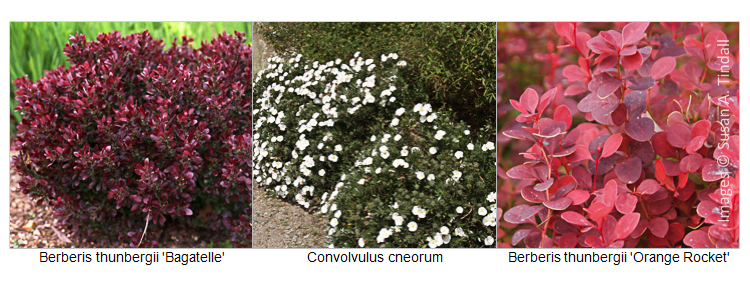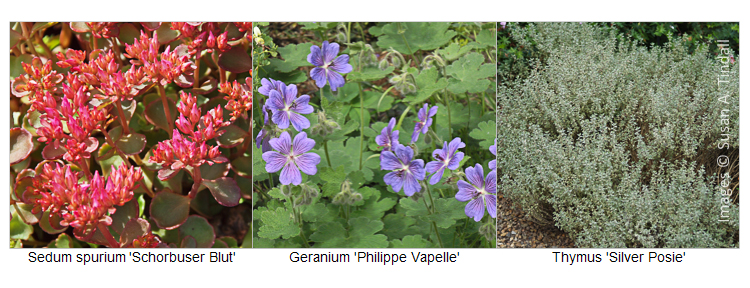Along with the dream of the instant, fully-fledged garden is the wish for a garden that is largely maintenance-free. It can be satisfying to have a bed that can largely be left to its own devices, except for weeding, and to just see what happens.
Here is a suggestion for a planting that has well-behaved plants that generally know their place, and require a minimum of attention. It has more texture than bright colour, but there is silver and purple and changing foliage colours in the mix. These plants like well drained soil and an open, sunny position and this is not for the coldest parts of the country. It could be planted as a walk-around bed or traditionally with shrubs to the rear and smaller plants at the front edge. The effect should be informal and almost easy-going.
First choose a few shrubs. Berberis thunbergii forms are useful, especially the vertical varieties which only spread slightly with age. Try Berberis thunbergii ‘Orange Rocket’ which has coral-orange spring colour, greens up for summer and turns fiery red in autumn before leaf fall. If there is room, plant three or five across the central area or at the rear in a conventional border. In total contrast the small rounded Berberis thunbergii f. atropurpurea ‘Bagatelle’makes rounded humps of red-purple foliage. This can be scattered informally amongst the waving grasses and perennials that make up most of the planting. Include a few specimens of the small silver-leafed shrub Convolvulus cneorum that likes a dry position and likewise provides pleasing neat mounds of colour.
The herbaceous contribution for the middle ground of the planting is simple with several, well-spaced spreading clumps of Geranium x riversleaianum ‘Russell Pritchard’ with rose magenta flowers in summer. It combines well with the silver foliage of the convolvulus. The clumps can occasionally be divided in spring if they become too portly. Next, plant several Euphorbia griffithii ‘Fireglow’ with its striking flat heads of burnt-orange flowers that are a feature in spring. This looks good with the spring foliage of ‘Orange Rocket’. In autumn it turns red and orange before the foliage dies back. The euphorbia can occasionally be divided in spring if it becomes too large. In summer the plant forms striking clumps of elegant green leaves with red central ribs. The final plant for this simple mix is many clumps of the delicate waving grass Stipa tenuissima that is silvered green in summer. It looks beautiful with the solid mounds of purple ‘Bagatelle’ as well as the silver of the convolvulus. The only attention this plant needs is to carefully pull off the old foliage in early spring, holding the plant firmly so you don’t pull it out of the ground!
Round the edges of this planting put a number of well-spaced Geranium ‘Philippe Vapelle’ with soft blue-purple flowers in early summer and quietly beautiful foliage. This can be divided occasionally in spring as per ‘Russell Pritchard’. Include clumps of the silver foliage of Thymus ‘Silver Posie’. This is trimmed after flowering to retain a compact habit. Finally, give space to the trailing Sedum spurium forms such as Sedum spurium ‘Schorbuser Blut’ which hugs the ground. The plant forms neat rosettes, and is smothered in bright red flowers in summer. Pull it out if needed and replant bits at the base of shrubs or in any bare patches.
The repetition of a few plants is easy on the eye and contributes to a natural effect. Trust your judgement when placing plants informally, and remember, they can always be moved! It is deeply satisfying to rest your eyes on a group of plants that you have successfully planted yourself.
More information and care instructions for all the plants in this article can be viewed in the Garden for pleasure plant finder
Many of the plants mentioned above can be purchased from Crocus.co.uk
Enjoy!
Susan A Tindall



